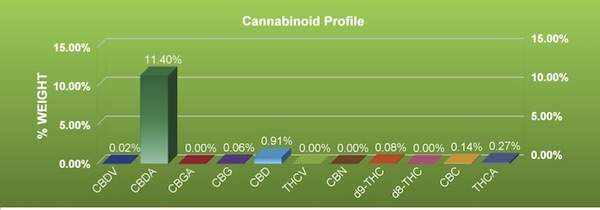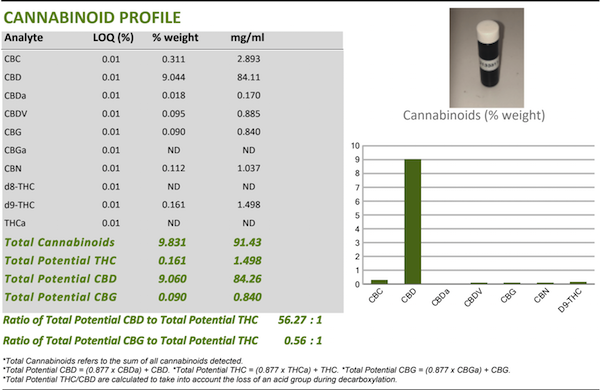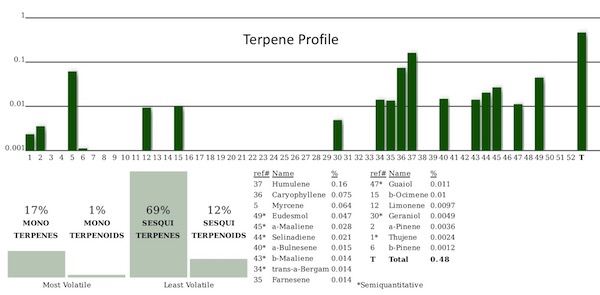All reputable companies selling CBD or hemp products will have their product(s) tested by an independent laboratory both before processing and after infusing the extract with the final product, be it edibles, tinctures or oil. If a company does not readily display COA’s for all of its products, you can assume the worst.
Most COA’s will have three components:
1) A cannabinoid profile, showing not only CBD and THC content, but also the amount of other known cannabinoids that may be minimally detected.
2) A terpene profile, showing the terpenes (essential oil-like aromas) present, and
3) Negative results after testing for mold, fungi, heavy metals, solvents or pesticides.
Canabinoid Profile
The following is an example of a canabinoid profile from a dried hemp flower:

Please note that there are 11 possible canabinoids present, and that CBDA, CBGA, and THCA are all acid forms of CBD, CBG and THC respectively, meaning they contain an additional carboxyl group at the end of their molecular chain, which is lost when the flower is heated above 110 degrees Celsius, a process called decarboxylation.
Since this is raw flower, which has yet to be processed or smoked (decarboxylated), it is assumed that .133 % of the acid form will be lost in the process. In determining final CBD, CBG, or THC content for testing purposes, it is therefore assumed that .877% will remain after being decarboxylated.
In this example, Total THC is determined by multiplying THCA (.27%) by .877 and adding d9-THC (.22% X .877 + .08% = .31679%)
Total CBD is determined by multiplying CBDA (11.40%) by .877 and adding CBD (11.40% X .877 + .91% = 10.9078%)
Weight percentages are calculated from mg/g (milligrams/gram) by moving the decimal one point to the left, and conversely, from mg/g to Weight % by moving the decimal one point to the right.
The following is an example of a canabinoid profile from MCT oil infused with CBD extract:

Note that most of the acid was decarboxylized from CBDA into CBD and all of the THCA was converted to THC in the extraction process before being infused with oil.
This sample was from a one-ounce (30 ml) tincture advertising 2500 mg of extract. Thus, the total potential CBD (CBD + CBDA) is 84.26 mg/ml or 84.26 X 30 =2,528 mg
Often weights can be expressed in mg/g (milligrams/gram) In order to convert grams to ml, divide your weight (in grams) by the density (in g/ml for water, 1ml = 1gram, for coconut oil, 1ml = .924 grams.
Terpene Profile
Terpenes and terpenoids are the lesser-known compounds present in the cannabis plant, which are responsible for flavor and smell. Terpenes are simple hydrocarbons that can be found in plants, trees, animals and insects. Terpenoids are derived from terpenes, and are complex compounds with different functional groups and oxidized methyl groups.
Currently, there are over 20,000 known terpenes, and the cannabis plant is known to produce about 150. Terpenes are categorized into 4 different groups: hemiterpenes, monoterpenes, sesquiterpenes, and diterpenes, which contain 1,2,3, and 4 isoprene molecules, respectively
The following is a terpene profile from a dried flower indicating 17 terpenes:

Note that the monoterpenes are more volatile (easily evaporated) than the sesquiterpenes. Most of the terpenes are lost if the temperature during drying/curing exceeds 70 degrees farenheit. Likewise, to preserve terpenes, they must be removed before decarboxylation, and then added back into the final product after cannabinoid extraction.
Quantitative Impurities and Chemical Residue Screening
Test results for mold, fungi, heavy metals, solvents and pesticides are extremely important and will be expressed in PPM (parts per million). A typical test should show ND (not detected) for all of the above.